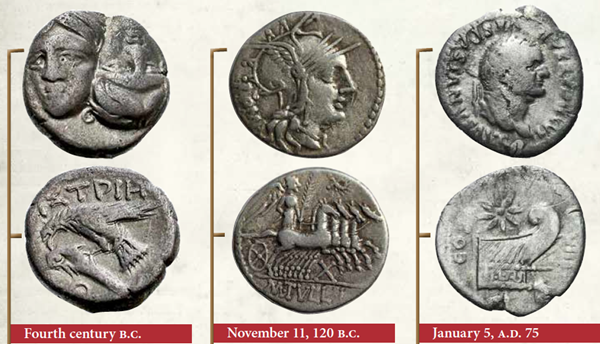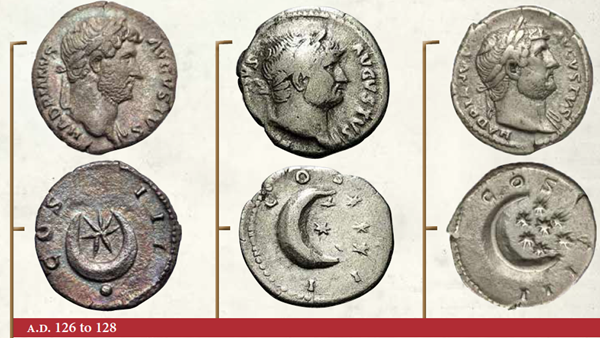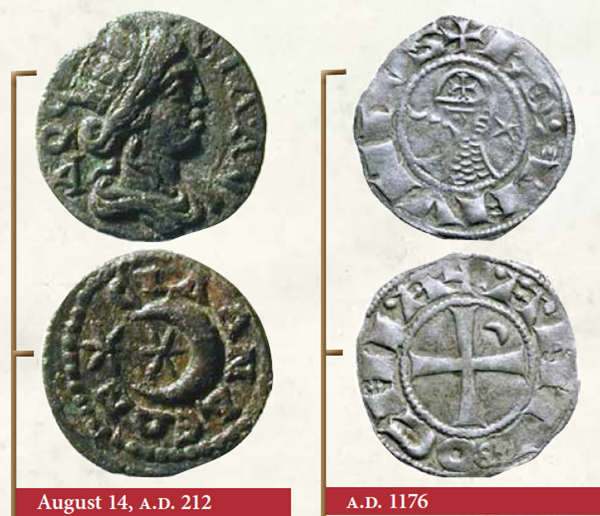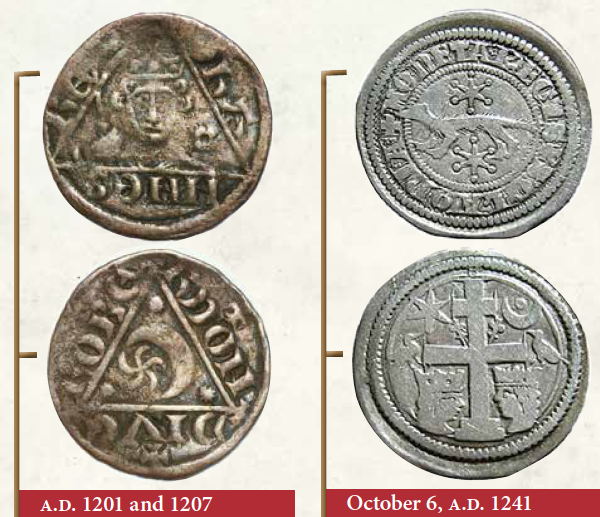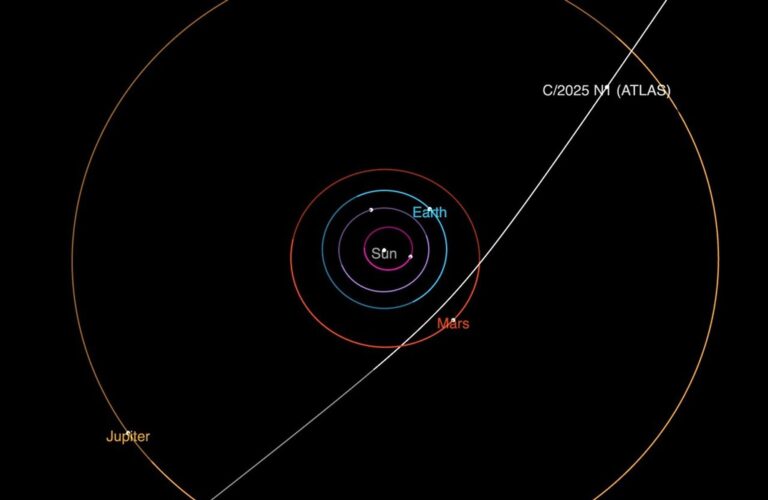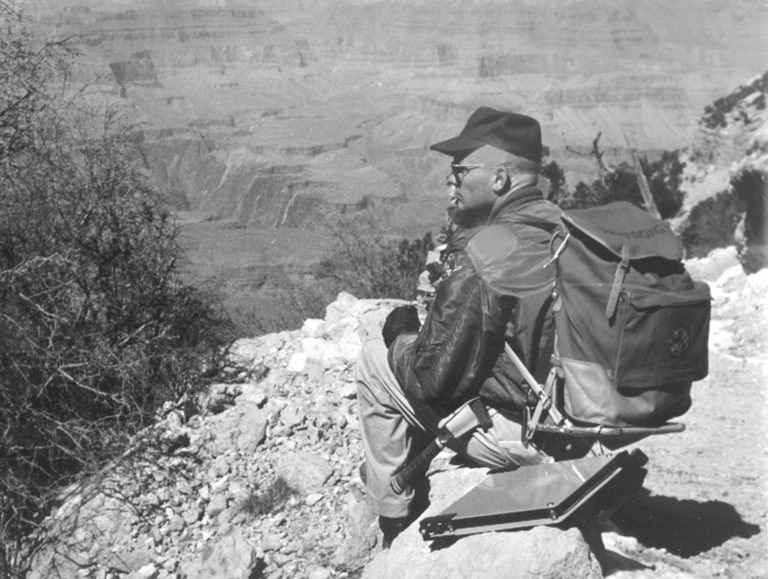Key Takeaways:
Left: This silver coin from the Greek city-state of Istros is smaller than a dime, yet twice as thick. Two heads (one inverted) of Apollo appear on the obverse, and the reverse shows an eagle carrying off a dolphin. These coins might commemorate two solar eclipses, one in 434 B.C. and another a scant three years later in 431 B.C.
Middle: The mint of M. Tullius in the Roman republic issued this dime-sized silver coin, called a denarius, after the hybrid-total eclipse on November 11, 120 B.C. The obverse features the winged head of Victory, and the reverse shows a chariot drawn by four horses. Above is a wreath of fire representing the eclipsed Sun.
Right: A denarius with the Rogman emperor Vespasian on the obverse and a ship’s prow plus a “star” (the eclipsed Sun) on the reverse was produced to commemorate the total solar eclipse of January 5, A.D. 75, and probably to celebrate renewed stability in the Roman Empire.
The earliest verifiable eclipse observation was made June 15, 763 b.c., by the Assyrians. This was soon followed by well-documented viewings recorded by the Chinese and Greeks. But it was the Chaldean astronomers of the Neo-Babylonian Empire who first deduced the Sun-Moon eclipse connection known as the saros cycle.
This period, 6,585.3211 days, is the length of time after one total solar eclipse when a nearly identical eclipse will occur. Armed with this new knowledge, the Chaldeans, and later the Greeks and Romans, could explain the cause of eclipses and — more importantly — predict when they would happen. This allowed the Romans to use eclipses as a propaganda device to promote military campaigns or political agendas.
The mints open
Around the same time, the Greeks came up with a pretty nifty invention — coinage. At first the designs were quite crude, but in the span of a few generations, they became nothing less than works of art. The sheer variety of themes soon rivaled the number of Greek city-states scattered throughout the Mediterranean world.
Starting in Greece, those who minted coins used them in ways beyond their stated use as money. Commemorating an event or a person could curry favor with those in power. Honoring natural events — such as eclipses, which would have been experienced by many — or military victories could instill within the populace a sense of unity or nationalistic pride. What finally appeared on individual coins was up to the imagination of the minter.
One of the most unusual designs came from Istros, a small city-state on the coast of the Black Sea near the mouth of the Danube River. Made from about 400 b.c. to 350 b.c., the coins featured two inverted identical heads of the god Apollo, always presented anti-parallel, on the obverse (front). Scholars have offered a number of explanations for the heads, including that they represented the rising and setting Sun, that the pair was supposed to be the Dioscuri (the twins Castor and Pollux), and even that the heads symbolized branches of the river Ister (Danube).
But in 2005, William C. Saslaw and Paul Murdin from the Institute of Astronomy at the University of Cambridge in England hit upon the idea that these coins commemorated solar eclipses. In a span of only three years, there were two solar eclipse events: The first occurred at 6:30 a.m. on October 4, 434 b.c., when the heavily eclipsed Sun rose out of the Black Sea. (The line of totality lay about 100 miles [160 kilometers] north.) In fact, the rising Sun would have appeared as a thin crescent, and in the span of 10 minutes, the tips of its “horns” would have switched to point in the opposite direction, much like the inverted heads. Three years later on August 3, 431 b.c., during the Peloponnesian War, an annular eclipse visible from Istros produced the same horned solar crescent pattern, but this time in the late afternoon. Because Istros was a busy commercial center, regional officials spun these events as signs of good times, which may have resulted in producing this series of coins.
Unlike Greek coins, which can be notoriously hard to date due to a number of factors, several series of Roman eclipse coins have been linked to events. Perhaps the earliest, and certainly one of the most intriguing, was minted from 217 b.c. to 215 b.c. The Roman Republic was locked in the Second Punic War with Carthage and had already lost several major engagements to the great general, Hannibal Barca.
Perhaps out of sheer desperation, the Roman ruling class saw the total solar eclipse of February 11, 217 b.c., as an omen of better things to come. To honor it, Rome produced an unusual bronze coin with a radiant visage of Apollo; the reverse had an almost whimsical “smiley face” consisting of a solar crescent, two stars, and a pellet. Did it help achieve the desired soothing effect? It’s hard to say, but in the end the Romans did eventually triumph.
One hundred years later, fortunes had greatly improved for the Romans with major victories over the Celts of southern Gaul (France). A series of coins was minted to commemorate the eclipse of November 11, 120 b.c., which was seen as a blessing by the gods. The eclipse was a hybrid-annular type, much like the May 30, 1984, event in the eastern United States.
The reverse of the coin features a winged Victory driving a chariot of four horses with a fiery wreath burning in the sky. It doesn’t take too much imagination to see that the wreath is the eclipsed Sun, with Bailey’s beads and large prominences dotting the rim.
A new era dawns
By the turn of the first century a.d., Rome had become a mighty empire, spanning across the entire Mediterranean Sea and much of Europe. After several years of turmoil following the end of Nero’s chaotic reign, stability finally returned under the no-nonsense reign of Vespasian.
On January 5 in the year 75, a total solar eclipse was seen in southern Italy and northern Africa. In Rome, more than 90 percent of the Sun was obscured. Perhaps to mark the start of more good times, the mints produced a silver denarius — a dime-sized silver coin — displaying a ship’s prow with a brilliant star (the eclipsed Sun) above it, guiding the ship to safe waters.
Left: This small bronze coin, about the size of a penny, was produced shortly after the eclipse of August 14, 212, in the Roman province of Lydia in western Turkey. From there, the Moon covered 95 percent of the Sun. Of interest are the two “stars” on the reverse. They represent Jupiter and Venus, both of which would have been easily visible to the unaided eye during the event.
Right: During the Middle Ages, it was common to interpret astronomical events such as solar eclipses as signs from the heavens. This silver denarius was minted in Antioch during the reign of Bohemond III. It sports a simple design, a commemoration of the total solar eclipse of 1176, whose path of totality passed directly over the city.
Perhaps the most beautiful and well-known series of Roman eclipse coins appeared during the height of the empire. The first series of silver denarii was minted from 126 to 128, during the early part of the reign of the emperor Hadrian. The reverse of these coins shows a thin crescent plus one to seven stars, with four- and six-star versions being the rarest of the set.
Many scholars had thought that this crescent represented the Moon. Our satellite’s crescent phase is a normal occurrence, however, and if the seven stars were the five planets plus Earth and Moon, why repeat? An eclipsed Sun is a better explanation. And indeed, on September 3, 118, a spectacular total solar eclipse cut across the northern Roman Empire. This event certainly could have provided the artistic inspiration for the coin series.
An even longer lasting eclipse coin series was minted during the Roman Severan dynasty. On December 28, 186, people in the region of the western Mediterranean watched an annular eclipse setting in the winter sky. From Rome, the Moon covered more than 70 percent of the Sun, which appeared as a brilliant crescent as it sank below the western horizon.
For seafarers and citizens of Rome, this celestial spectacle must have been an awesome sight. As for the coin series, it was minted primarily in bronze for more than four decades (and through the reign of several emperors). It also featured a crescent with one to seven stars.
Through the centuries, the Greeks and Romans minted thousands of different coins with astrological and astronomical motifs, yet few are the subjects of research. Several years ago, fellow amateur astronomer and collector Jerry Armstrong contacted me regarding a small coin from the Roman province of Lydia in western Turkey. The design on the reverse consisted of a crescent and two stars — but was it an eclipse coin?
After a bit of research, we found that a total solar eclipse occurred August 14, 212, with the path running across the Black Sea, southern Europe, and just south of Rome. In Lydia, the lunar disk covered more than 95 percent of the Sun, while ships just offshore would have been treated to totality. Because the coin was minted between 212 and 215, the correlation is good. But what was the significance of the stars? They were the bright planets Jupiter and Venus, and both would have been easily visible during totality.
The Middle Ages
By a.d. 1000, nearly all aspects of the ancient Roman world were gone. Christianity and Islam had replaced pagan beliefs. However, astrologers still were making predictions about the future. They, as well as the general population, saw solar eclipses and comets in particular as omens of change, and coins depicting those events were commonplace. Let’s examine the circumstances of a few examples and their impact on the feudal world.
One of the most infamous of all English rulers was John Lackland, better known as King John, the youngest brother of Richard the Lionhearted. Much maligned by history, John had a disagreeable personality that offset whatever good traits he may have had. But he seldom let an opportunity for self-promotion go by. In 1201 and 1207, the tracks of two annular eclipses passed quite close to the British Isles. In London, observers would have seen the Moon covering 67 percent and 76 percent of the Sun’s disk, respectively.
Right: A stylized portrait of King John Lackland of England — the villainous “Prince John” of the Robin Hood stories — is shown on the obverse of this thin silver coin. On the reverse is a crescent Moon plus a starlike Sun. The minting of this coin, perhaps used as a propaganda device to herald future good tidings, commemorated annular eclipses in 1201 and 1207.
Left: The total eclipse of October 6, 1241, broadly visible across Southern Europe and Asia Minor, had a major impact on coin design. This example from Slavonia (now Croatia) has a stoic design typical of those times. The obverse features a wolflike predator with two stars, while the reverse shows a cross surrounded by a star and crescent, a large star, and portraits of two rulers.
Luckily, King John wasn’t the only game in town. For several centuries, the Crusades had a huge impact on everyday life, and during that time, eclipses were used to promote great victories and other events. A popular example was minted in Antioch during the reign of Bohemond III. This city was on the centerline of the total solar eclipse of April 11, 1176, and the event was likely a major influence on the design of a silver coin.
Another eclipse that inspired the creation of several coins took place six decades later. The path of totality of the great eclipse of June 3, 1239, cut across Asia Minor and most of southern Europe. The greatest duration of totality was 5 minutes and 59 seconds. A scant two years later, on October 6, 1241, another total eclipse crossed southeastern Europe.
These events had a major impact on coin design across the region for several decades. A couple of fine examples include a silver coin from Slavonia (Croatia) and an exotic coin from the Sultanate of Rum showing an attacking lion with the Sun and three luminaries — possibly Venus, Saturn, and Mercury.
The Enlightenment and beyond
By the early 18th century, the science of eclipse prediction had progressed to a point where astronomers could accurately pin down the location and duration of the paths. However, it would take much longer for the general populace to drop the old superstitions and accept the science. Classic examples are the medallions produced by both sides of the conflict at the end of the Siege of Barcelona (April 2–27, 1706) during the War of the Spanish Succession.
As a large English fleet pulled into the harbor carrying reinforcements, the siege was quickly lifted, and Spanish and French forces soon began to leave the city. On the morning of May 12, the retreating forces witnessed more than four minutes of totality. It didn’t take long before people were calling the event the “eclipse of the Sun King,” referring to Louis XIV of France. On the side of the victors, Queen Anne of Britain had bronze and silver commemorative medals produced, the reverse depicting Barcelona Harbor and the radiant eclipsed Sun rising over it.
On the losing side, the Habsburgs produced a medal for King Charles III of Spain showing a similar scene on the reverse. But instead of a tranquil harbor, it displays the eclipsed Sun over a city under siege with the phrase along the rim “VNIVS LIBERATIO ALTERIVS OPRESSIO,” or “the liberation of one(s), oppression of others.”
Today, we no longer regard total solar eclipses with mystery and dread, although we still celebrate them in coins and medals. And thanks to the internet, we have relatively easy access to resources that let us conduct research on eclipse coins.
The Greeks and Romans produced literally tens of thousands of different coins, and thousands more were minted in the Middle Ages. Many have not yet been cataloged, let alone examined for possible connections to astronomical events. It’s still a wide-open field, limited only by your ability to do online research. Give it a shot — you might just make an interesting discovery!

